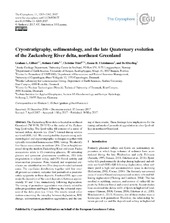Cryostratigraphy, sedimentology, and the late Quaternary evolution of the Zackenberg River delta, northeast Greenland
Peer reviewed, Journal article
Published version

Åpne
Permanent lenke
https://hdl.handle.net/1956/17625Utgivelsesdato
2017-05-30Metadata
Vis full innførselSamlinger
- Department of Earth Science [1034]
Sammendrag
The Zackenberg River delta is located in northeast Greenland (74°30′ N, 20°30′ E) at the outlet of the Zackenberg fjord valley. The fjord-valley fill consists of a series of terraced deltaic deposits (ca. 2 km2) formed during relative sea-level (RSL) fall. We investigated the deposits using sedimentological and cryostratigraphic techniques together with optically stimulated luminescence (OSL) dating. We identify four facies associations in sections (4 to 22 m in height) exposed along the modern Zackenberg River and coast. Facies associations relate to (I) overriding glaciers, (II) retreating glaciers and quiescent glaciomarine conditions, (III) delta progradation in a fjord valley, and (IV) fluvial activity and niveo-aeolian processes. Pore, layered, and suspended cryofacies are identified in two 20 m deep ice-bonded sediment cores. The cryofacies distribution, together with low overall ground-ice content, indicates that permafrost is predominately epigenetic in these deposits. Fourteen OSL ages constrain the deposition of the cored deposits to between approximately 13 and 11 ka, immediately following deglaciation. The timing of permafrost aggradation was closely related to delta progradation and began following the subaerial exposure of the delta plain (ca. 11 ka). Our results reveal information concerning the interplay between deglaciation, RSL change, sedimentation, permafrost aggradation, and the timing of these events. These findings have implications for the timing and mode of permafrost aggradation in other fjord valleys in northeast Greenland.
